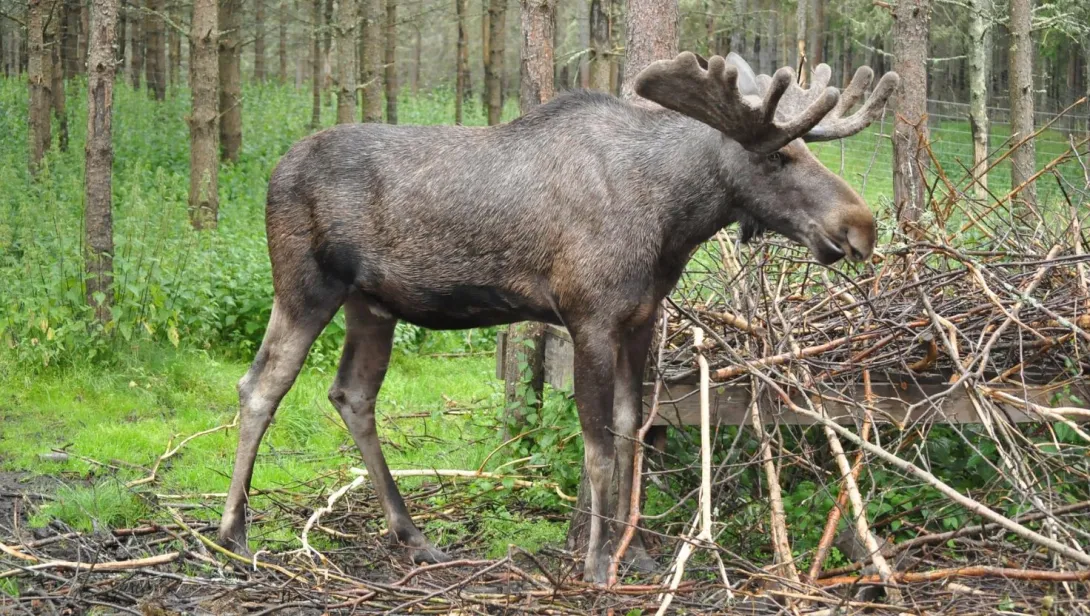Skip to main content
General Information
- The Moose (Alces alces) is the largest species of deer in the world.
- It is native to North America, Europe, and Asia, thriving in boreal forests.
- Moose are solitary animals and do not form herds like other deer species.
- They are strong swimmers and often inhabit areas near lakes, rivers, and wetlands.
- Moose are herbivores, feeding on leaves, twigs, bark, and aquatic plants.
Physical Characteristics
- Adult males, called bulls, can weigh between 380 to 700 kg (840 to 1,500 lbs).
- Females, known as cows, are smaller, weighing around 200 to 490 kg (440 to 1,080 lbs).
- Moose can stand up to 2.1 meters (7 feet) at the shoulder, making them the tallest land mammals in North America.
- Bulls grow large, broad, palmate antlers that can span up to 1.8 meters (6 feet).
- They have a long, drooping nose and a distinctive flap of skin called a dewlap or "bell" hanging from their throat.
- Moose have thick, dark brown fur that insulates them against extreme cold.
Habitat and Adaptation
- Moose primarily live in cold climates and are found in forests, marshes, and tundra.
- They are well adapted to snowy environments due to their long legs and large hooves.
- Moose use their hooves to dig through snow and to defend against predators.
- Their wide nostrils help them warm up cold air before it reaches their lungs.
- They can tolerate extreme cold but struggle in hot temperatures, often seeking shade or water.
Diet and Feeding Behavior
- Moose are browsers, meaning they eat leaves, twigs, and bark rather than grass.
- They feed on a variety of plants, including willows, birches, aspens, and aquatic vegetation.
- During summer, they often feed in lakes and ponds, diving to eat underwater plants.
- An adult moose can consume up to 32 kg (70 lbs) of food daily.
- They have a four-chambered stomach, similar to cows, to help digest tough plant material.
Social Behavior
- Moose are mostly solitary, except during the mating season and when cows are raising calves.
- They communicate using grunts, bellows, and body language.
- Calves stay with their mothers for about one year before becoming independent.
- During winter, moose may gather in small groups in areas with plentiful food.
Reproduction and Lifespan
- The mating season (rut) occurs in September and October.
- Bulls compete for females by engaging in antler fights and vocal displays.
- After a gestation period of about 8 months, cows give birth to one or two calves in spring.
- Newborn calves weigh around 11 to 16 kg (25 to 35 lbs) and grow rapidly.
- Moose have an average lifespan of 15-25 years in the wild.
Threats and Conservation
- Moose face threats from habitat destruction, climate change, hunting, and predators.
- Wolves, bears, and cougars are their main natural predators, especially for young calves.
- Warmer temperatures lead to increased tick infestations, which can weaken moose.
- Many regions regulate moose hunting to maintain stable populations.
- Conservation efforts focus on habitat preservation and managing disease outbreaks.
Interesting Facts
- Moose are excellent swimmers and can dive up to 6 meters (20 feet) to reach aquatic plants.
- They can run up to 56 km/h (35 mph) despite their large size.
- Moose have poor eyesight but rely on their strong sense of smell and hearing to detect danger.
- Their antlers can weigh up to 30 kg (65 lbs) and are shed every winter.
- Unlike other deer species, moose do not form large herds but prefer a solitary lifestyle.
